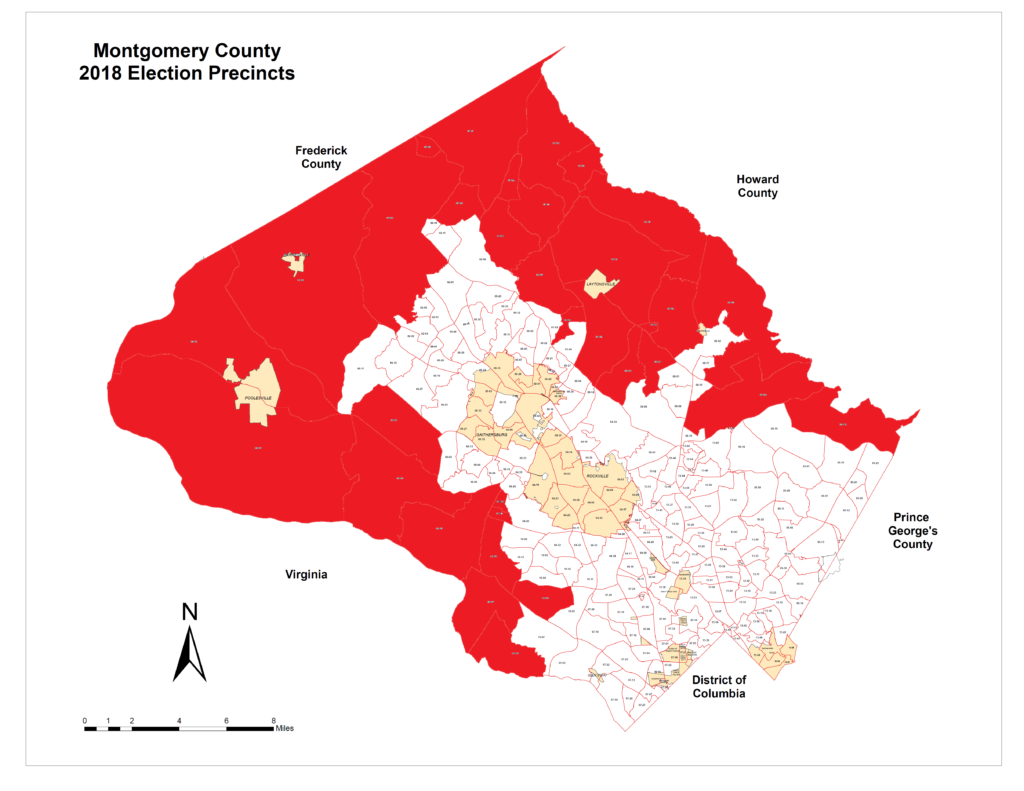By Adam Pagnucco.
In Part One, I explained the primary reason why the county’s Republican Party leadership supports Nine Districts, even going so far as to use the party’s official website to raise money for the group. The Republicans believe that having nine county council districts instead of five could produce one (or more) districts in which Republicans could compete. Using 2018 general election data, I built a 32-precinct district that accounts for one-ninth of the county’s registered voters and maximized Republican electoral participation while minimizing Democratic participation. (I used registered voters as an admittedly imperfect proxy for population.) Here is what my so-called Red District looks like on a precinct map.
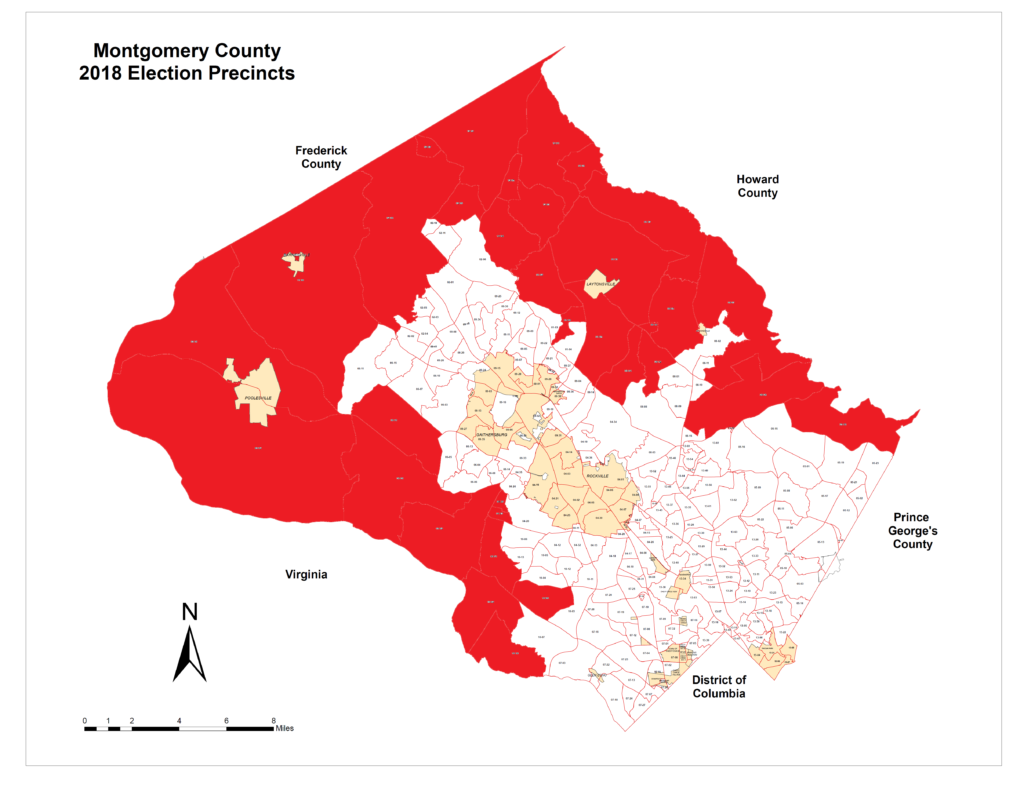
The Red District has the strongest presence of Republicans and the weakest presence of Democrats of any contiguous district I can construct. But could it actually elect a Republican to the county council? Let’s find out.
First, let’s compare the eligible voters by party as of the 2018 general election between the county as a whole and the Red District.
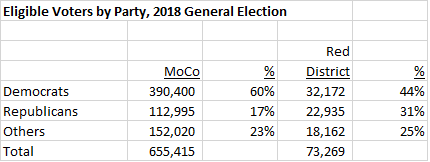
In the county as a whole, Democrats had a 43-point advantage over Republicans in eligible voters. In the Red District, the Democratic advantage shrank to 13 points. Democrats still held a plurality in the Red District, but with 44% of eligible voters, they were not a majority.
Now let’s look at actual voters.
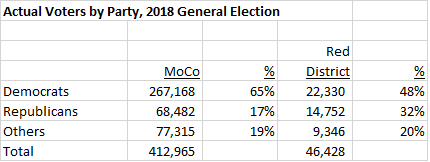
Among actual voters, Democrats had a 48-point advantage over Republicans countywide. (2018 was a year in which Democrats were highly motivated to vote by the current occupant of the White House.) But in the Red District, the Democratic advantage shrank to 16 points. Once again, Democrats were a plurality but not a majority of Red District voters.
The table below shows the performance of the two major-party gubernatorial candidates, Democrat Ben Jealous and Republican Larry Hogan, in the county as a whole and in the Red District. Only election day votes are shown because precinct data does not include other voting modes.
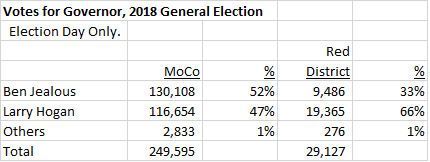
Jealous won the election day vote countywide by 5 points. (Counting all voting modes, Jealous won MoCo by 11 points.) But in the Red District, Hogan blew out Jealous by 33 points on election day. Clearly, the Red District is VERY different from the rest of the county in its preference for governor.
But Hogan is an unusual Republican whose popularity extends well into the Democratic voting base. Judging a propensity to favor the GOP by looking at Hogan’s vote tallies alone is problematic. And so, as a proxy for hypothetical support for a generic Republican, I calculated the combined votes for the Democratic council at-large candidates (Gabe Albornoz, Evan Glass, Will Jawando and Hans Riemer) and the Republican council at-large candidates (Robert Dyer, Chris Fiotes, Penny Musser and Shelly Skolnick) for both the county as a whole and the Red District. Those results are shown in the table below.
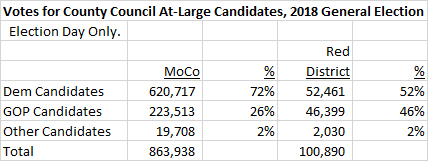
In the county as a whole, the Democratic council at-large candidates totally blew out the Republicans by 72-26%. That’s why the Republican leadership hates the at-large seats as much as they do – Democrats can roll up their vote totals in Silver Spring, Takoma Park, Chevy Chase, Bethesda and Kensington and Republicans can’t pick up enough votes elsewhere to win. But in the Red District, the Democratic council at-large candidates only had a 6-point edge. Compared to the rest of the county, that’s a narrow margin.
Let’s remember that 2018 saw massive Democratic turnout in reaction to the individual in the Oval Office. That makes it an unusual year. Given that fact, the above data suggests that in a more normal year, a strong Republican council candidate could defeat a weak Democrat in the Red District. That’s the dream of MoCo Republicans. And that’s why they support Nine Districts.
Now, would something like the Red District actually be created in a nine district system? That’s hard to know. Redistricting is nominally within the purview of a commission appointed by the council every ten years, but the council can substitute its own map if they wish. That means if Nine Districts passes, council Democrats will effectively design the districts directly or indirectly. They could scatter rural Republicans around two or three districts (perhaps one based in Potomac, another based in Clarksburg and maybe a third based in Damascus). Doing that would create two or three competitive general elections. Or they could do what state-level Democrats did in designing the current congressional districts, which was to pack Republicans in one district (Congressman Andy Harris’s District 1). If they elected to go that route, they would design something very close to my Red District.
One thing is for sure: the Republican Party would be jumping up and down to get a chance to compete. They don’t have that in the current system. But they might have it if voters approve nine districts.

